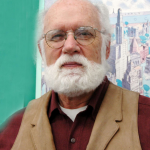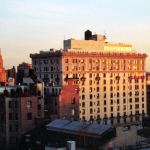
Ask a historian: What’s the story behind the Brooklyn Heights Promenade?

Pam from Brooklyn Heights asked: With all the controversy over reconstruction of the BQE and The Promenade, what was the original plan?
Disastrous! The Promenade wouldn’t have even existed.
The BQE would have bisected Brooklyn Heights and the Promenade/Esplanade would not have been born, according to Henrik Krogius, former editor at the Brooklyn Eagle and author of The Brooklyn Heights Promenade. He points out that the only precedent was an 1827 proposal by Hezekiah Pierrepont, the original Heights landlord, but he was overruled by his neighbors.
Another concept recommended a BQE route along Furman Street with private gardens on top for those whose backyards faced the Manhattan skyline. Without the super highway devised by Robert Moses, no Promenade. All hinged on schemes of New York’s “master builder,” Moses, probably the most powerful public official in New York history. Robert Caro’s magnificent critical biography, The Power Broker, reveals the details.
Moses believed the future of America lay in the automobile, even though he never drove one. In his mind, public transportation was dead. Pedestrians didn’t matter. He had started building roads in rural areas: upstate, in farmland, on private property using eminent domain. Then, with World War II on the horizon, he capitalized on roads for military transport arguing for national safety.
Today’s Belt Parkway originated as the Circumferential Highway to connect New York’s military bases. Think of the expressways and parkways as “walls” that divide communities.
Several concepts were born in 1939 and mushroomed during the war years. The Belt met the new BQE, but what about those houses in Red Hook, Gowanus, Sunset Park and Williamsburg?
Moses used the word “slum clearance,” particularly if the neighborhood was poor and had immigrants. The rich had perks then, too.
At the end of World War II, Brooklyn Heights was not the jewel of Brooklyn it is today. Many brownstones were demolished, others divided into rooming houses that could be purchased for $25,000 or less. Historian Kenneth Jackson pointed out that the streets were dangerous after dark and that foreign sailors from the waterfront roamed the streets. But slums?
In the initial plan, the new BQE would continue from Cobble Hill along an open cut “ditch” by Hicks Street, move east near Pierrepont to Tillary Street, then continue to the present roadway.
Another plan, in a 1942 Eagle story, suggested the route would cut across Monroe Place and Pierrepont, demolishing part of the new Appellate Courthouse. Other routes discussed: a Henry Street route and a six-lane highway along Furman Street.
During construction of the triple-cantilever structure, Moses hid in his Heights office, secreted in the Margaret Hotel on Columbia Heights so he could observe the BQE construction and the demolition of prime housing in the Heights.
The eight-block Promenade opened in 1954. “Where else are you going to find something like the Brooklyn Heights Esplanade?” asked nyroads.com.
While creations of Robert Moses dot the city landscape, his “linear city” of elevated highways never reached completion. The complete master plan in his head materialized sporadically in reality. His dream of a Cross Brooklyn Expressway from the Verrazzano Bridge through Nostrand-Flatbush on a LIRR rail bed to Queens was given up in 1966. The Brooklyn-Battery Bridge became a tunnel. The Bushwick Expressway along Broadway never left the design table.
Manhattan was another target for Moses, who pushed for elevated highways above Broome Street (Lower Manhattan Expressway), the Mid-Manhattan Expressway over 30th Street and the Cross Harlem Expressway for starters. Plans existed for the other boroughs. If all had been completed, New York City might have more roads and cars than communities.
Protests from the Brooklyn Heights Association, journalist Jane Jacobs, singer Bob Dylan (“Listen Robert Moses”) and other civic groups helped restore sanity to urban life.
Again, in this topsy-turvy world we need sanity again. The plan is still being discussed with Scott Stringer’s alternative for an additional “Cobble Hill Linear Park” among the suggestions.
We need more sanity. Help save The Promenade!
Ask a Historian is written by John B. Manbeck, the former Brooklyn Borough Historian. To find answers to your questions about our fair borough and its history, fill out the form below.
Leave a Comment
Leave a Comment





